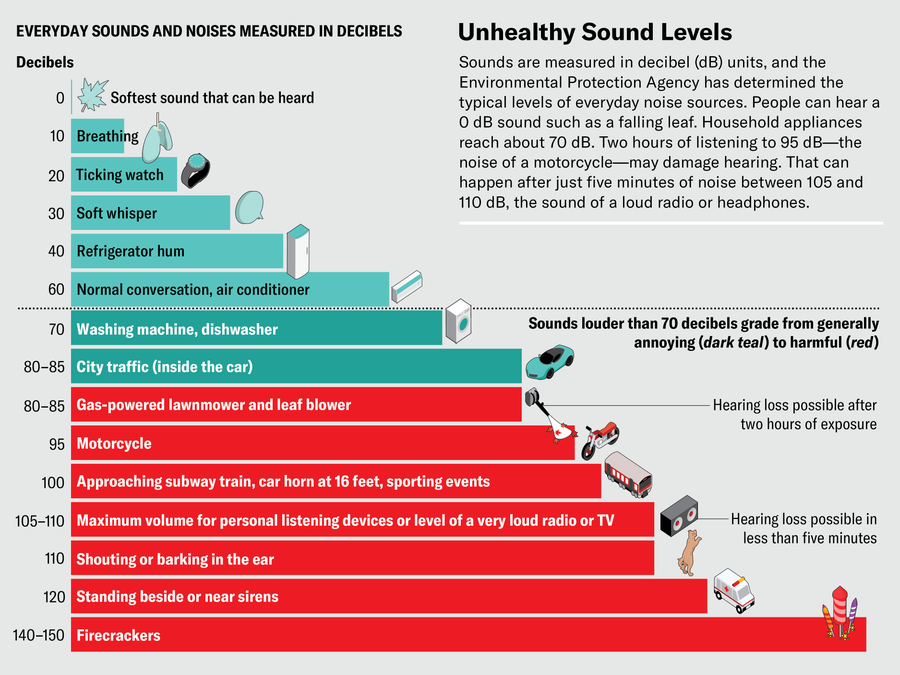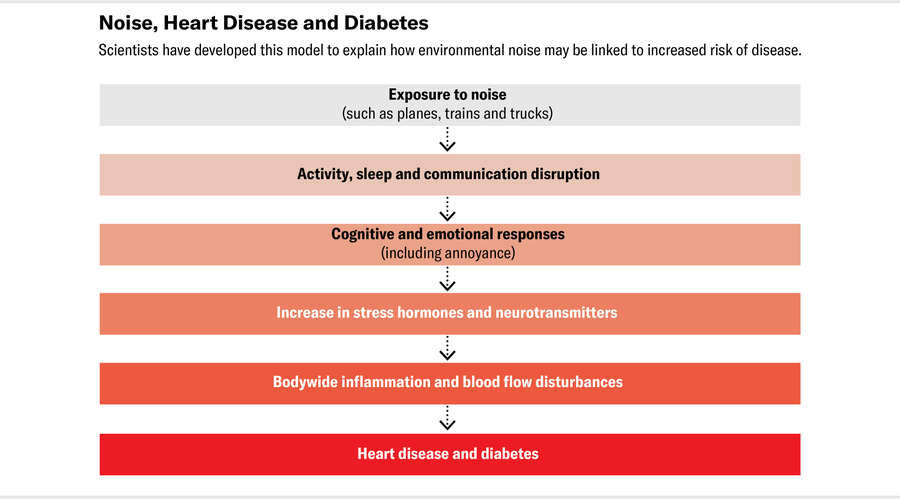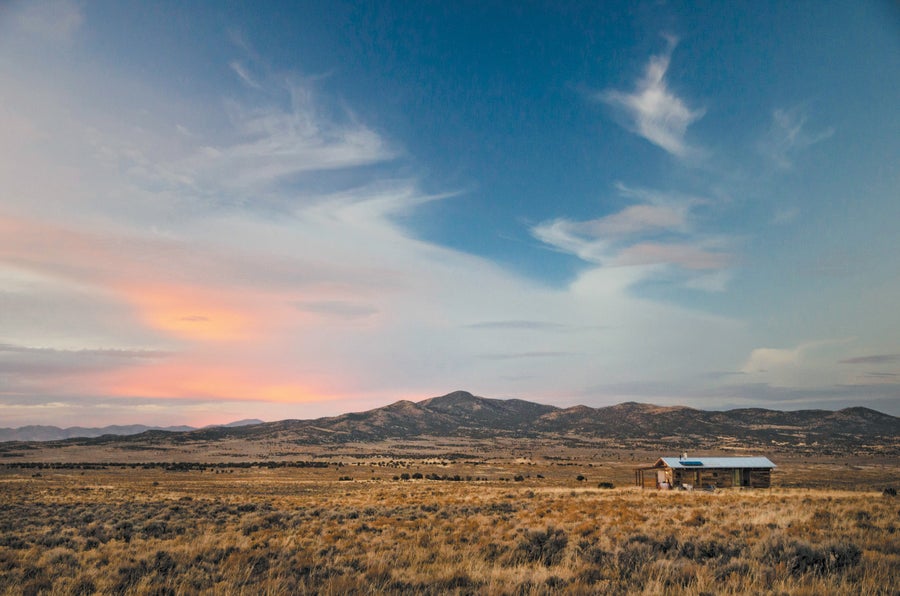Ten years ago Jamie Banks started working from her home in the town of Lincoln, Mass. After a couple of months, the continuing racket from landscaping machines began to feel unendurable, even when she was inside her home. “This horrible noise was going on for hours every day, every week—leaf blowers, industrial lawnmowers, hedge trimmers,” she says. The sound of a gas-powered leaf blower outside can be as loud as 75 decibels (dB) to someone listening from inside a house—higher than the World Health Organization cutoff to protect hearing over a 24-hour period. “I started thinking, this can’t be good,” she says. “It’s definitely not good for me. It certainly can’t be good for the workers operating the equipment. And there are lots of kids and lots of seniors around. It can’t be good for them either.”
几年前,杰米-班克斯开始在马萨诸塞州林肯镇的家中工作。几个月后,园艺机器持续不断的噪音开始让她感到难以忍受,即使她在家里也是如此。"她说:"这种可怕的噪音每天、每周都要持续几个小时--吹叶机、工业用割草机、树篱修剪机。在屋外用燃气吹叶机吹出的声音,对于在屋内聆听的人来说可能高达 75 分贝(dB),高于世界卫生组织规定的 24 小时内保护听力的分界线。"我开始想,这肯定不是好事,"她说。"这对我肯定不是好事。对操作设备的工人肯定也不好。周围有很多孩子和老人。这对他们也不好。
Banks is a health-care specialist and environmental scientist who has worked most of her life as a consultant on health outcomes and behavior change for government agencies, law firms and corporations. She decided to do something about her situation and got together with a like-minded neighbor to pester the town government. It took the pair seven years to get their town to do one thing—ban gas-powered leaf blowers during the summer. The process was long and frustrating, and it made Banks think about going bigger and helping others.
班克斯是一名保健专家和环境科学家,她的大部分时间都在为政府机构、律师事务所和公司担任健康结果和行为改变方面的顾问。她决定为自己的处境做点什么,于是和一位志同道合的邻居一起缠着镇政府。这对夫妇花了七年时间才让他们的小镇做了一件事--禁止夏季使用燃气吹叶机。这个过程漫长而又令人沮丧,这让班克斯想到要做得更大,去帮助其他人。
So she did. In June 2023 Quiet Communities, a nonprofit group that Banks founded and runs, sued the U.S. Environmental Protection Agency for not publishing or enforcing rules and regulations to limit loud sounds: unmuffled motorcycles, cacophonous factories, the thunder of an airplane just overhead, the roar of an elevated train, the scream of a soundtrack in a spin class, headphones set too loud. There is a federal law that calls for the EPA to do this, but it hasn’t been enforced for more than 40 years.
所以她做到了。2023 年 6 月,由班克斯创建并管理的非营利组织 "安静社区 "起诉美国环境保护局,指控其没有发布或执行限制高噪音的规章制度:没有消音的摩托车、喧闹的工厂、头顶的飞机雷声、高架列车的轰鸣声、旋转课上原声带的尖叫声、耳机声音过大。有一项联邦法律要求环保局这样做,但已有 40 多年没有执行了。
Banks’s idea that loud noise “can’t be good” is well supported by science. Noise can damage more than just your ears. Through daytime stress and nighttime sleep disturbances, loud sounds can hurt your heart and blood vessels, disrupt your endocrine system, and make it difficult to think and learn. The World Health Organization calculated that in 2018 in the European Union, 1.6 million years of healthy life were lost because of traffic noise. The organization recommended that to avoid these health effects, exposure to road traffic noise should be limited to below a weighted 24-hour average of 53 dB (the sound of a campfire from about 16 feet away) during the day, evening, and night and 45 dB specifically at night (the sound of light traffic about 100 feet away).
班克斯认为巨大的噪音 "不会是好事",这种观点是有科学依据的。噪音损害的不仅仅是你的耳朵。通过白天的压力和夜间的睡眠干扰,响亮的声音会伤害你的心脏和血管,扰乱你的内分泌系统,使你难以思考和学习。据世界卫生组织计算,2018 年,欧盟因交通噪音损失了 160 万年的健康寿命。该组织建议,为避免这些健康影响,白天、傍晚和夜间接触道路交通噪声的时间应限制在加权 24 小时平均值 53 分贝(约 16 英尺外的篝火声)以下,特别是夜间应限制在 45 分贝(约 100 英尺外的轻微交通声)以下。
Precise “safe” levels to avoid specific ailments are hard to come by. But in general, research shows, reducing loud noise can reduce the risk of harm. There are several ways to protect yourself. Various organizations have made maps that indicate quiet and noisy places around the U.S. Smartphone apps can tell you if you’re in one that’s too loud for safety. And noise experts all seem to own earbuds and headphones and use them often to block out the din.
很难找到避免特定疾病的精确 "安全 "水平。但研究表明,一般来说,减少噪音可以降低伤害风险。有几种方法可以保护自己。各种组织绘制了地图,标明了美国各地安静和嘈杂的地方。智能手机应用程序可以告诉您,您所在的地方是否太吵而不安全。噪音专家似乎都拥有耳塞和耳机,并经常使用它们来屏蔽噪音。
For most of human history, the issue with noise was simply how annoying it can be. The first noise ordinance on record was drafted by Julius Caesar shortly before his assassination in 44 B.C.E., limiting the times that noisy carts and wagons could be on the street. The modern industrial era brought regulations to protect the ears of workers exposed to steam engines, drop forges, and other loud machinery but little information or action on everyday noises. A big moment came in 1970, when psychoacoustics expert Karl Kryter, then at the Stanford Research Institute, published The Effects of Noise on Man. The book focused on what loud sound could do to hearing and touched on work performance, sleep, vision and blood circulation.
在人类历史的大部分时间里,噪音问题仅仅是一个令人讨厌的问题。公元前 44 年,凯撒大帝在被刺杀前不久起草了第一部噪音法规,限制了街上可以停放高噪音马车的时间。现代工业时代出台了相关法规,以保护暴露在蒸汽机、锻造机和其他高噪音机器下的工人的耳朵,但几乎没有针对日常噪音的信息或行动。1970 年,斯坦福研究所的心理声学专家卡尔-克里特(Karl Kryter)出版了《噪音对人的影响》一书,这是一个重要的时刻。该书重点阐述了高噪音对听力的影响,并涉及工作表现、睡眠、视力和血液循环。
That noise has biological effects beyond the ear makes sense in evolutionary terms. Noise may signal that a herd of elephants is charging your compound or that a pack of wolves is close by—you need to know, and your body needs to get ready for something unpleasant. As noise and sleep researcher Mathias Basner of the University of Pennsylvania and his colleagues put it in a 2014 Lancet review, “evolution has programmed human beings to be aware of sounds as possible sources of danger.”
从进化论的角度来看,噪音对生物的影响超出了耳朵的范围。噪音可能预示着一群大象正在向你的院落发起进攻,也可能预示着一群狼就在附近--你需要知道,你的身体也需要做好准备,以应对不愉快的事情。正如宾夕法尼亚大学的噪音与睡眠研究员马蒂亚斯-巴斯纳及其同事在2014年《柳叶刀》杂志的一篇评论中所说的那样,"进化已经为人类设定了程序,让他们意识到声音可能是危险的来源"。

MSJONESNYC; Source: Centers for Disease Control and Prevention (reference)
MSJONESNYC; 来源:美国疾病控制和预防中心(参考资料)
From an evolutionary point of view, sleep was “a very dangerous stage,” a time when you had to maintain attention to your environment, Basner says. But the psychiatrist and epidemiologist, who has spent much of his career studying the effects of airport noise on people sleeping nearby, notes a “watchman function” that leads to night awakenings is for the most part harmful, not helpful, in modern societies.
巴斯纳说,从进化的角度来看,睡眠是 "一个非常危险的阶段",在这个阶段,你必须保持对周围环境的关注。但这位精神病学家和流行病学家的大部分职业生涯都在研究机场噪音对附近睡眠者的影响,他指出,导致夜间惊醒的 "守夜功能 "在现代社会中大多是有害而非有益的。
A lot of people think they sleep soundly despite nearby noise. They should think again. Basner has exposed hundreds of people to noise during sleep studies. He says many would get up in the morning swearing they’d slept through the night without waking, but the data showed they’d had numerous awakenings.
很多人认为,尽管附近有噪音,他们也能睡得很香。他们应该再想一想。巴斯纳曾在睡眠研究中让数百人接触噪音。他说,很多人早上起床时都会发誓自己睡了一夜而没有醒来,但数据显示他们醒来了很多次。
By the early 1970s a poll showed that the public considered noise pollution a serious problem. Formal government recognition came in 1972 with the passage of the Noise Control Act and the establishment of the EPA’s Office of Noise Abatement and Control. The act promised that the government would “promote an environment for all Americans free from noise that jeopardizes their health or welfare.” At the time, the EPA estimated that 100 million Americans experienced daily average sound of 55 dB or over. Fifty-five dB is about halfway between the level of a quiet conversation at home and one in a restaurant or office. Any 24-hour exposure average louder than that, according to the EPA, was loud enough to interfere with activities and cause annoyance.
到 20 世纪 70 年代初,一项民意调查显示,公众认为噪声污染是一个严重的问题。1972 年,随着《噪声控制法案》的通过和环保局噪声消减与控制办公室的成立,政府正式承认了这一问题。该法案承诺,政府将 "为所有美国人创造一个没有危害其健康或福利的噪音的环境"。当时,环保局估计有 1 亿美国人的日平均噪音为 55 分贝或以上。55 分贝大约介于家中安静谈话与餐厅或办公室谈话之间。根据环保局的说法,任何 24 小时平均暴露声级超过 55 分贝的声音都足以干扰活动并造成困扰。
By this time, studies from universities in the U.S. and Europe were beginning to identify health effects of noise beyond the ear, starting with behavior and learning. In 1973 three U.S. researchers, with funding from the National Science Foundation and two private organizations, studied 73 children in primary school who lived in several 32-story apartment buildings clustered over Interstate 95 where it passes through New York City. Children on the lower floors, exposed to more highway noise, were less able to distinguish sounds and were reading at a lower level than children on the higher floors. There was even a dose-response relation: the longer the child had lived in the building, the lower their scores were likely to be.
此时,美国和欧洲各大学的研究已开始发现噪声对健康的影响不仅限于耳朵,还包括行为和学习。1973 年,三名美国研究人员在美国国家科学基金会和两家私人机构的资助下,对 73 名小学儿童进行了研究,这些儿童住在 95 号州际公路经过纽约市的几栋 32 层公寓楼里。与较高楼层的儿童相比,较低楼层的儿童受到更多公路噪音的影响,分辨声音的能力较差,阅读水平也较低。甚至还出现了剂量反应关系:孩子在楼里住的时间越长,他们的分数就可能越低。
In 1975 researchers at the City University of New York looked at school records for 161 primary school students at a school that was 220 feet from an elevated subway, with trains hurtling by every 4.5 minutes. The records showed a three- to four-month reading lag for kids in classrooms on the noisy side of the building compared with those in classes on the quiet side.
1975 年,纽约市立大学的研究人员调查了一所学校 161 名小学生的学籍档案,这所学校距离高架地铁 220 英尺,每 4.5 分钟就有一列火车疾驰而过。记录显示,与安静一侧的教室相比,嘈杂一侧教室的孩子在阅读方面要落后三到四个月。
Researchers were able to do a natural experiment when the Munich International Airport moved about 25 miles north in 1992. The scientists found that among children living near the old airport site, long-term memory and reading skills improved after the airport closed. But for kids near the new airport, those changes went in the opposite direction, and their stress hormone levels increased.
1992 年,慕尼黑国际机场向北迁移了约 25 英里,研究人员得以进行一次自然实验。科学家发现,机场关闭后,居住在旧机场附近的儿童的长期记忆力和阅读能力都有所提高。但对于新机场附近的孩子们来说,这些变化却恰恰相反,他们的压力荷尔蒙水平上升了。
In the early 2000s Stephen Stansfeld, then a psychiatrist at the University of London, studied kids aged nine to 11 living and going to school near airports in Europe, comparing their blood pressure and learning ability with those of similar children who did not live under flight paths. Airplane noise reached 77 dB(A) at several schools; dB(A) is a decibel scale that emphasizes frequencies the human ear hears best. “We found a straight-line relationship between increasing levels of aircraft noise and children’s reading comprehension,” Stansfeld says. “Noisy schools were not healthy educational environments.” A colleague found the harmful effects lasted into secondary school.
本世纪初,时任伦敦大学精神病学家的斯蒂芬-斯坦斯菲尔德对居住在欧洲机场附近并在机场附近上学的 9 至 11 岁儿童进行了研究,将他们的血压和学习能力与不住在航道附近的同龄儿童进行了比较。在几所学校,飞机噪音达到了77分贝(A);分贝(A)是一个分贝表,强调人耳能听到的最佳频率。"斯坦斯菲尔德说:"我们发现,飞机噪音水平的增加与儿童的阅读理解能力之间存在直线关系。"嘈杂的学校不是健康的教育环境"。一位同事发现,这种有害影响会持续到中学。
All the while, the U.S. was getting noisier. In 2014 Rick Neitzel, an environmental and occupational health professor at the University of Michigan who has been researching noise for 25 years, and his colleagues estimated that more than 100 million Americans had a continuous average exposure level in 24 hours of greater than 70 dB. Imagine standing next to a washing machine all day or suffering occasional blasts from the gas-powered lawn equipment Jamie Banks could hear inside her house. It was a rise of 15 dB in just a generation, which is the difference between normal conversation and a vacuum cleaner.
与此同时,美国却变得越来越嘈杂。2014 年,密歇根大学环境与职业健康教授里克-内策尔(Rick Neitzel)和他的同事们估计,超过 1 亿美国人 24 小时内的连续平均暴露水平超过 70 分贝。想象一下,杰米-班克斯整天站在洗衣机旁边,或者在屋内偶尔听到燃气草坪设备发出的轰鸣声。在短短一代人的时间里,噪音就上升了 15 分贝,这相当于正常谈话和吸尘器之间的差别。
Beyond the brain and cognition, the heart and blood vessels also take a hit from noise—perhaps not surprising given the stressful effects of noise and the impacts of stress on the circulatory system. A slew of epidemiological studies over the years have linked environmental noise, especially nighttime noise, to high blood pressure, heart failure, myocardial infarction (heart attacks) and stroke. The association held true even after researchers controlled for confounders such as air pollution and socioeconomic variables.
除了大脑和认知能力,心脏和血管也会受到噪声的影响--鉴于噪声的压力效应和压力对循环系统的影响,这也许并不奇怪。多年来的一系列流行病学研究表明,环境噪声,尤其是夜间噪声,与高血压、心力衰竭、心肌梗塞(心脏病发作)和中风有关。即使在研究人员控制了空气污染和社会经济变量等混杂因素后,这种关联仍然存在。
Some of the strongest human data come from Denmark, which is an epidemiologist’s dream country because it collects health data on pretty much every resident. Mette Sørensen, an epidemiologist at Roskilde University in Denmark, Thomas Münzel, a professor at Johannes Gutenberg University in Germany, and others teased apart the effects of noise on types of heart disease such as myocardial infarction, angina and heart failure. Looking at 2.5 million people 50 years or older, they found road traffic noise increased the incidence of all three. In a 2021 report on 3.6 million Danes, they showed that an average daily 10-dB increase in sound exposure because of road noise increased the risk of stroke by 3 to 4 percent.
丹麦是流行病学家梦寐以求的国家,因为它收集了几乎所有居民的健康数据。丹麦罗斯基勒大学流行病学家梅特-索伦森(Mette Sørensen)、德国约翰内斯-古腾堡大学教授托马斯-明泽尔(Thomas Münzel)等人研究了噪音对心肌梗塞、心绞痛和心力衰竭等心脏病类型的影响。他们对 250 万 50 岁以上的人进行了调查,发现道路交通噪音会增加这三种疾病的发病率。在 2021 年一份关于 360 万丹麦人的报告中,他们发现,由于道路噪音,平均每天的声音暴露增加 10 分贝,中风的风险就会增加 3%到 4%。
They’ve also looked at type 2 diabetes, a condition that had already been associated with chronic sleep disturbance. This link makes sense, Sørensen says: stress such as frequent awakening raises levels of glucocorticoids, which inhibit insulin secretion and insulin sensitivity. Reducing these two things leads to diabetes. In 2013 Sørensen and her colleagues reported an 8 percent increase in diabetes risk for every 10-dB increase in exposure to road traffic noise. Eight years later, looking at 3.56 million Danes 35 years and older, with 233,912 new cases of diabetes, they calculated that road traffic noise could be blamed for 8.5 percent of the cases of diabetes in Denmark and railway noises for 1.4 percent.
他们还研究了 2 型糖尿病,这种疾病已经与长期睡眠障碍有关。索伦森说,这种联系是有道理的:频繁醒来等压力会提高糖皮质激素的水平,而糖皮质激素会抑制胰岛素分泌和胰岛素敏感性。降低这两点会导致糖尿病。2013 年,索伦森和她的同事们报告说,暴露在道路交通噪音中的时间每增加 10 分贝,糖尿病风险就会增加 8%。八年后,他们对356万名35岁及以上的丹麦人和233912个糖尿病新病例进行了调查,计算出丹麦8.5%的糖尿病病例可归咎于道路交通噪音,1.4%的糖尿病病例可归咎于铁路噪音。
Sørensen is aware that those percentages don’t sound very high. But they are meaningful, she says. In Denmark, more than one third of the population is exposed to average daily sound levels above 58 dB. “You have such a huge proportion exposed to this,” she says, “so even though it’s only a really small increase in risk, it’s a large number of people who get diabetes due to noise.”
Sørensen 意识到,这些百分比听起来并不高。但她说,这是有意义的。在丹麦,超过三分之一的人口暴露在日平均声级超过 58 分贝的环境中。"她说:"暴露在这种环境中的人口比例如此之大,因此,尽管增加的风险非常小,但因噪声而患糖尿病的人数却非常多。
The physical mechanisms behind these links are still being investigated, but animal studies have highlighted possible culprits. (Researchers cannot deliberately expose people to such potentially harmful noise effects.) Münzel explored some of these connections in mice, for example. In one study, he exposed the rodents to average sound levels of 72 dB over four days and found that the animals had higher blood pressure and levels of stress hormones and inflammation, as well as changes in the activity of genes that regulate vascular health and cell death.
这些联系背后的物理机制仍在研究之中,但动物研究已经强调了可能的罪魁祸首。(研究人员不能故意让人暴露在这种可能有害的噪音影响下)。例如,Münzel 在小鼠身上探索了其中的一些联系。在一项研究中,他将啮齿动物暴露在平均声级为 72 分贝的环境中四天,结果发现这些动物血压升高,应激激素和炎症水平升高,调节血管健康和细胞死亡的基因活动也发生了变化。

Jen Christiansen; Source: “Environmental Noise and the Cardiovascular System,” by Thomas Münzel et al., in Journal of the American College of Cardiology, Vol. 71; February 2018 (reference)
Jen Christiansen;来源:《环境噪声与心血管系统》,作者 Thomas Münzel 等人,载于《美国心脏病学会杂志》,第 71 卷;2018 年 2 月(参考文献):"环境噪声与心血管系统》,作者:Thomas Münzel 等,发表于《美国心脏病学会杂志》,第 71 卷;2018 年 2 月(参考文献)
In the U.S., most research on noise has been done without much help from the federal government, despite the Noise Control Act. In 1981, after Ronald Reagan was elected president on a promise of cutting back the federal government, he appointed Anne Gorsuch as head of the EPA; she eliminated funding for the agency’s noise-control office. “She wanted to show the White House that she believed in small government,” says Sidney Shapiro, a Wake Forest administrative law professor who has studied the rise and fall of noise-abatement laws. He says noise has never had a well-organized constituency to support it. Responsibility for noise-control research, funding and regulation was left to individual state and local governments.
在美国,尽管有《噪声控制法案》,但大多数噪声研究工作都没有得到联邦政府的大力协助。1981 年,罗纳德-里根(Ronald Reagan)因承诺削减联邦政府而当选总统,他任命安妮-戈萨奇(Anne Gorsuch)为环保局局长;她取消了该局噪声控制办公室的经费。"维克森林大学行政法教授西德尼-夏皮罗(Sidney Shapiro)研究了噪声控制法律的兴衰,他说:"她想向白宫表明,她相信小政府。他说,噪音从来没有得到过组织良好的支持者的支持。噪音控制研究、资金和监管的责任被留给了各个州和地方政府。
Today the EPA’s noise-control office is still there—on paper. “There is no money to enforce regulations or for research or education,” Neitzel says. That’s why Quiet Communities is suing. “Not having the EPA doing its job is hugely damaging, not only to the public who are being harmed by noise but also to the research community. We don’t have access to a stream of funding that should be there.”
如今,环保局的噪声控制办公室仍然存在,只是纸上谈兵。"Neitzel 说:"没有钱来执行法规,也没有钱进行研究或教育。这就是安静社区提起诉讼的原因。"环保局不履行职责不仅对受噪声危害的公众造成巨大伤害,而且对研究界也是如此。我们无法获得本应存在的资金流"。
Without that information, noise researchers have long struggled to quantify the overall impact of the American din. In 2014 when Neitzel and his colleagues at the University of Michigan wanted to figure out whether reducing noise would have a beneficial effect on cardiovascular disease, they had to resort to prevalence estimates made in 1981. In 2015 they published their findings. A 5-dB reduction in average noise exposure would cut the prevalence of high blood pressure by 1.5 percent and cut heart disease by 1.8 percent. Again, these are low numbers. But because of the high incidence of these conditions to begin with, an average 5-dB reduction would have an annual economic benefit of $3.9 billion. “I was shocked that the numbers were as big as they were,” Neitzel says.
没有这些信息,噪音研究人员长期以来一直难以量化美国喧嚣的总体影响。2014年,当密歇根大学的内策尔和他的同事们想弄清减少噪音是否会对心血管疾病产生有益影响时,他们不得不求助于1981年的流行率估算。2015 年,他们公布了研究结果。将平均噪音暴露降低 5 分贝,可使高血压发病率降低 1.5%,心脏病发病率降低 1.8%。同样,这些数字都很低。但由于这些疾病的发病率本来就很高,平均降低 5 分贝将带来每年 39 亿美元的经济效益。"Neitzel说:"这些数字之大令我震惊。
Overall, as with chemical and air pollution, people with lower incomes are being hit the hardest. Their communities may have highways running through them or have factories and airports nearby. “Folks who are already in marginalized communities may be bearing way more than their fair share of noise exposure,” Neitzel says.
总体而言,与化学污染和空气污染一样,低收入人群受到的影响最大。他们的社区可能有高速公路穿过,或者附近有工厂和机场。"Neitzel说:"已经处于边缘化社区的人们所承受的噪音可能远远超过了他们应该承受的份额。
In these areas, it’s essential to ground research and solutions in community priorities, says Erica Walker, an epidemiologist at Brown University. Walker founded the Community Noise Lab, which works with communities to study and mitigate the effects of noise and other pollutants. She believes that it’s probably not just the absolute sound level that determines bodily damage—it’s unwanted sound. If the sound is a welcome one, does prolonged exposure to, say, 75 dB (about the volume of street musicians playing trumpets 30 feet away from you) raise stress levels the way that large studies have shown? “We need to know what the difference is between sound and noise from an individual point of view and from a community perspective,” Walker says.
布朗大学流行病学家埃里卡-沃克(Erica Walker)说,在这些领域,研究和解决方案必须以社区优先事项为基础。沃克创建了社区噪音实验室,与社区合作研究并减轻噪音和其他污染物的影响。她认为,决定身体损害的可能不仅仅是绝对声级,而是不受欢迎的声音。如果声音是一种受欢迎的声音,那么长期暴露在例如 75 分贝(大约是街头音乐家在离你 30 英尺远的地方吹小号的音量)的环境中,是否会像大型研究显示的那样提高压力水平呢?"沃克说:"我们需要知道,从个人角度和社区角度来看,声音和噪音之间有什么区别。
She points to the Shaw neighborhood of Washington, D.C., which has been undergoing gentrification. “The cultural practice was to play go-go music. As the neighborhood began to become gentrified, newcomers had their own acoustical expectations of what the neighborhood should sound like,” Walker says. “If I’m going into a community and I’m measuring noise and I’m saying it’s really loud (based strictly on decibels) and harmful to health, that might be a misclassification.” People already in the community might perceive that noise as comfortable.
她指出,华盛顿特区的肖街区正在经历城市化。她说:"当时的文化习俗是放 go-go 音乐。沃克说:"随着社区开始绅士化,新来者对社区的声音有了自己的期望。"沃克说:"如果我走进一个社区,测量噪音,然后说它非常吵(严格基于分贝),对健康有害,这可能是一种错误的分类。已经住在社区里的人可能会认为噪音很舒适。
Walker and her colleagues are now trying to tease apart unacceptable noise and acceptable sound. In an ongoing study, they’ve been asking volunteers how they feel about different kinds of noise. Then the researchers deconstruct those noises by rearranging them, making them unidentifiable as a specific sound but maintaining the decibel level and frequency spectrum (think high notes and low notes). By the end of this summer, Walker hopes to know whether the deconstructed sound matches up with the recognizable sound. Such information could help distinguish the roles of sound intensity and cultural connotation in human harm.
沃克和她的同事们现在正试图将不可接受的噪音和可接受的声音区分开来。在一项正在进行的研究中,他们一直在询问志愿者对不同种类噪音的感受。然后,研究人员通过重新排列来解构这些噪音,使其无法识别为一种特定的声音,但保持分贝水平和频谱(想想高音和低音)。沃克希望到今年夏天结束时,能知道解构后的声音与可识别的声音是否吻合。这些信息有助于区分声音强度和文化内涵对人类伤害的作用。
Whatever your community’s sound tolerance, you can protect yourself from noise that’s intolerable. The simplest way, of course, is to avoid it. Sørensen’s data show that sleeping on the quieter side of a building, away from the street, makes a difference. Or you can move to a quieter area. That is easier said than done, and all the experts I spoke with noted that moving to a more peaceful place, as many of them have, is possible only for people who can afford it. If you plan to move, Basner advises visiting the new area at different times of day.
无论您所在的社区对噪音的容忍度如何,您都可以保护自己免受无法忍受的噪音的影响。最简单的方法当然是避免噪音。索伦森的数据显示,睡在建筑物较安静的一侧,远离街道,会有不同的效果。或者你也可以搬到更安静的地方。说起来容易做起来难,与我交谈过的所有专家都指出,只有负担得起的人才有可能搬到更安静的地方,而他们中的许多人已经搬到了更安静的地方。如果您打算搬家,巴斯纳建议您在一天中的不同时间去新的地方看看。
For noise that can’t be avoided, science may offer some promise, at least for ear effects. Sudden loud noises (think concerts, jet engines, leaf blowers and loud machines) stimulate the delicate hair cells and nerve fibers in the inner ear, resulting in the release of damaging free radicals. Animal work has identified some promising chemicals to sop these molecules up, says Colleen Le Prell, a psychologist and head of the department of speech, language and hearing at the University of Texas at Dallas, who is working on several candidates. There is already a drug for children to prevent chemotherapy-induced hearing loss, but it has significant side effects and isn’t approved for general use.
对于无法避免的噪音,科学可能会带来一些希望,至少是对耳朵的影响。突然发出的巨大噪音(如音乐会、喷气式发动机、吹叶机和大音量机器)会刺激内耳中脆弱的毛细胞和神经纤维,从而释放出有害的自由基。德克萨斯大学达拉斯分校言语、语言和听力系主任、心理学家科琳-勒普雷尔(Colleen Le Prell)说,动物实验已经发现了一些有希望吸收这些分子的化学物质,她正在研究几种候选物质。目前已经有一种针对儿童的药物可以预防化疗引起的听力损失,但这种药物有很大的副作用,而且没有被批准普遍使用。

The Montello Foundation’s artist retreat in Nevada has been identified by the nonprofit Quiet Parks International as a community without irritating noise.
Stefan Hagen
斯特凡-哈根(Stefan Hagen),非营利组织 "国际静谧公园"(Quiet Parks International)将内华达州蒙泰罗基金会(Montello Foundation)的艺术家疗养地认定为 "无噪音社区"。
If you want to get a snapshot of the sound around you, the Internet can help. The National Institute for Occupational Health and Safety has a national map, but it works only on Apple mobile devices right now. The U.S. Department of Transportation has a map for transportation noise, but it doesn’t include workplace noise or inside noise. You can see noise across the entire country, albeit at pretty low resolution, on a National Park Service sound map.
如果你想了解周围的声音,互联网可以帮到你。美国国家职业健康与安全研究所有一张全国地图,但目前只能在苹果移动设备上使用。美国交通部有一张交通噪音地图,但不包括工作场所噪音或室内噪音。您可以在国家公园管理局的声音地图上看到全国的噪音情况,尽管分辨率很低。
To measure sound directly, there are plenty of smartphone apps. Don’t be surprised if the numbers are high. Data from Apple watches suggest that one in three adult Americans is exposed to excessive noise and daily averages of 70 dB(A) (the sound of an older washing machine or dishwasher) or greater. Those levels are considered by both the World Health Organization and the EPA as dangerous to the ear. You can see state-by-state results on Apple Hearing Study U.S. maps. Apple watches and iPhones can be set to alert you when sound reaches a particular level.
要直接测量声音,有很多智能手机应用程序。如果数字很高,请不要感到惊讶。苹果手表的数据表明,每三个成年美国人中就有一人暴露在过量的噪音中,每天平均噪音达到或超过 70 分贝(A)(老式洗衣机或洗碗机的声音)。世界卫生组织和美国环保署都认为这些噪音水平对耳朵有害。您可以在 Apple Hearing Study 美国地图上查看各州的结果。Apple 手表和 iPhone 可以设置为在声音达到特定级别时发出警报。
The data collected from Apple watches come from the Apple Hearing Study, begun in 2019 by Neitzel and his colleagues at the University of Michigan and funded by Apple. The study shows that a quieter world is possible. It took the lockdowns of COVID to prove it. The researchers got smartphone data from about 6,000 volunteers, covering a period from just before the pandemic began in January 2020 through late April of that year, when many businesses and activities had shut down for safety, and lots of people were staying close to home. The data showed a 3-dB(A) drop in noise exposure. Because decibels are measured on a logarithmic scale, that’s a halving of sound energy, easily noticeable by the human ear.
从苹果手表中收集的数据来自苹果听力研究,该研究由密歇根大学的内泽尔和他的同事于 2019 年开始,由苹果公司资助。这项研究表明,一个更安静的世界是可能实现的。这需要 COVID 的锁定来证明。研究人员从大约 6000 名志愿者那里获得了智能手机数据,时间跨度从 2020 年 1 月大流行开始前到同年 4 月下旬,当时许多企业和活动都因安全原因而关闭,很多人都待在家里。数据显示,噪音暴露下降了 3 分贝(A)。由于分贝是以对数标度测量的,这意味着声能减半,人耳很容易察觉到。
Sørensen moved from a city out into the country and checked a noise map first. Neitzel is very intentional about his exposure. “One thing that I absolutely try to do is make sure I’ve programmed periods into the day that I’m not going to have noise exposure,” he says. That means a bike ride through a quiet area or turning the TV off. If he’s at a bus stop, he stands back from the street as much as he can, and he routinely wears noise-blocking earplugs or earmuffs—sometimes both—when he’s checking out industrial sites.
Sørensen 从城市搬到乡村,首先查看了噪音地图。Neitzel 对自己暴露在噪音中的情况非常谨慎。"他说:"我绝对要做的一件事,就是确保我在一天中安排好不接触噪音的时间段。他说,"这意味着骑车穿过安静的区域或关掉电视。如果他在公交车站,他会尽量站在远离街道的地方,而且在查看工业场所时,他通常会戴上阻隔噪音的耳塞或耳罩,有时会同时戴上这两种东西。
Neitzel protects his ears at concerts as well. “There’s a bit of social stigma around wearing ear protection at a concert,” he says, so he wears clear plugs, much like many musicians use. And he’s got noise-canceling headphones and earbuds. They seal the ear to limit outside sound, which permits listening at a lower volume. He and his family wear noise-canceling earbuds on planes.
Neitzel 在音乐会上也会保护自己的耳朵。他说:"在音乐会上佩戴护耳设备会受到社会的鄙视,"因此他戴上了透明的塞子,就像许多音乐家使用的一样。他还有降噪耳机和耳塞。这些耳机和耳塞可以密封耳朵,限制外界声音,从而可以用较小的音量听音乐。他和家人在飞机上都戴着降噪耳塞。
You can ask others to turn sound down. Sharon Kujawa, an audiologist at Massachusetts Eye and Ear hospital in Boston, and her colleagues did an experiment to see whether people in spin classes preferred louder or softer sound. They liked softer. The facility managers were reluctant to make a change, but eventually customer requests got them to agree to a 3-dB decrease in volume. Fellow ear researcher Le Prell had her children use volume-limiting headphones. The kids were in marching bands in high school, in the percussion section, and she donated earplugs to the entire group.
您可以要求他人将声音调小。波士顿马萨诸塞州眼耳科医院的听力学家莎伦-库杰瓦和她的同事做了一个实验,看看人们在上体育课时喜欢大点的声音还是小点的声音。他们喜欢更柔和的声音。健身中心的经理们不愿意做出改变,但最终在顾客的要求下,他们同意将音量降低 3 分贝。耳科研究员 Le Prell 让她的孩子们使用音量限制耳机。孩子们在高中时参加了军乐队打击乐组,她向整个乐队捐赠了耳塞。
As for specific levels to aim for, that’s a tough one. There’s no formula that says x hours of exposure to road traffic noise will raise your risk of heart disease y percent. The EPA, which established its noise standards in 1974, before the full health effects were so clear, indicates that a 24-hour exposure level of 70 dB or less will prevent any hearing damage, and 55 dB outdoors and 45 dB indoors will prevent activity interference and annoyance. For lack of anything more current, that’s the standard used by many noise researchers today.
至于具体的目标水平,这是个难题。没有一个公式能说明,暴露在道路交通噪声中 x 小时会使患心脏病的风险增加 y%。美国环保局于 1974 年制定了噪音标准,当时对健康的全面影响还不是很清楚,该局指出,24 小时暴露在 70 分贝或更低的噪音水平下,可防止听力受损,室外 55 分贝和室内 45 分贝的噪音水平下,可防止活动干扰和烦扰。由于没有更先进的标准,如今许多噪声研究人员都采用这一标准。
In terms of protective devices, there are only limited federal regulations on headphones, and there’s some concern that the devices go up to volumes that can damage the health (ear and otherwise) of children. Volume limiters on headphones generally have an upper limit of 85 dB, but what the limit should really be, and for how long, is anybody’s guess. There’s also no solid research on whether devices that produce masking noises help.
就保护装置而言,联邦对耳机的规定有限,而且有人担心耳机的音量过高会损害儿童的健康(耳部和其他部位)。耳机上的音量限制器一般有 85 分贝的上限,但这个上限到底应该是多少,能持续多久,谁也说不准。至于产生掩蔽噪音的设备是否有帮助,目前也没有可靠的研究。
Clear, consistent standards for how much is too much, and what works, are unlikely without a revitalization of the EPA’s noise-control office. An agency spokesperson wouldn’t say whether the lawsuit by Quiet Communities will spur any change. The two sides in the suit “are currently in the midst of filing motions and cross-motions,” says Quiet Communities lawyer Sanne Knudsen of the University of Washington. When we spoke, Knudsen expected some kind of agreement would be reached by April and hoped it would be one that got the Office of Noise Abatement and Control up and running again.
如果不重振环保局的噪声控制办公室,就不可能为多少是过量以及什么有效制定明确、一致的标准。环保局发言人不愿透露 "安静社区 "的诉讼是否会带来任何改变。诉讼双方 "目前正在提交动议和交叉动议",华盛顿大学的安静社区律师 Sanne Knudsen 说。在我们采访时,克努森预计双方将在 4 月份达成某种协议,并希望该协议能让噪音消减与控制办公室重新开始运作。
Jamie Banks now spends most of her time in a quiet town in rural Maine, which, she says, is blissfully free of loud lawn equipment and other noise. She is optimistic that a newly active federal noise-control office will establish data-based noise limits and regulations and that the EPA will ensure regulations are enforced. In 1972, when the noise office was established, the Los Angeles Times opined that it wouldn’t mean an instant reduction in harmful sound, “but at least a start has been made.” Fifty-two years later Banks hopes for not just a start but real progress.
杰米-班克斯现在大部分时间都待在缅因州农村一个安静的小镇上,她说那里没有吵闹的草坪设备和其他噪音,非常幸福。她乐观地认为,新成立的联邦噪声控制办公室将制定基于数据的噪声限值和法规,环保局也将确保法规得到执行。1972 年,当噪音办公室成立时,《洛杉矶时报》认为,这并不意味着有害声音会立即减少,"但至少已经有了一个开始"。52 年后的今天,班克斯希望的不仅仅是一个开始,而是真正的进步。


